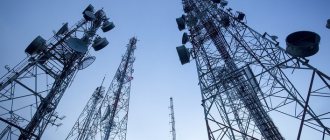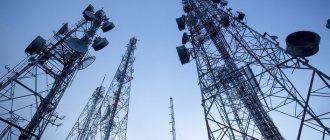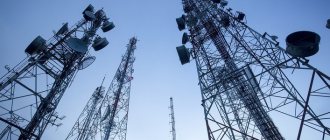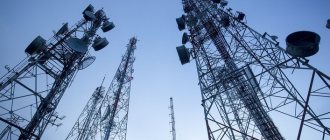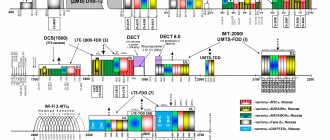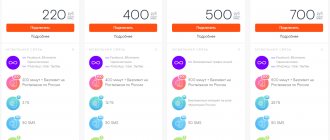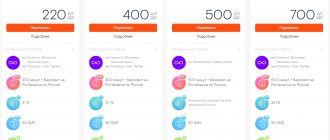Today, Russian mobile operators are actively expanding the coverage area of fourth generation networks. LTE is a term used to refer to networks with a throughput of at least 10 Mbps. 4G networks are a new communication standard, which is characterized, first of all, by fast connections and high quality voice calls.
List of LTE frequencies used by Russian mobile operators
The 4G networks of each domestic operator are located in a certain frequency range. The presented table contains information about LTE bands (from the English Band), which are supported in our country:
| Band name | Frequency |
| Band 3 | 1800-1880 MHz |
| Band 7 | 2620-2690 MHz |
| Band 20 | 790-820 MHz |
| Band 31 | 450 MHz |
| Band 38 | 2570-2620 MHz |
The LTE standard is not compatible with second and third generation networks, so special data transmission channels were allocated for it. Band is the frequency bands of any LTE network. The band number indicates the period when the given range began to be used in the world (there are currently 44 bands).
The bands presented in the table are used by each cellular operator. It should be noted that these frequency ranges are constantly expanding, which allows providers to provide Internet connections to a larger number of users.
In some cases, operators unite to build cell towers: a similar agreement was concluded in 2021 by Beeline and Megafon. Another example of cooperation was the agreement between Beeline and MTS, according to which the operators use common frequencies in the territory of some constituent entities of the Russian Federation.
The acquisition of bend frequencies occurs through open bidding, in which providers buy the right to broadcast their signal on certain channels. MTS, for example, spent 4 billion rubles on the 2500 MHz band, distributed throughout the Russian Federation except the Moscow region and Crimea. Tele2 was the first to launch 4G in the Kaliningrad region and a number of other regions of our country at a frequency of 450 MHz.
Beeline signal booster Moscow
Cellular signal strength is measured in dBm.
The scale shows the ratio of useful signal to noise. Stable coverage is a signal at a level of 72 – 60 dBm. Unstable: 120 - 103 dBm. The lower the indicator, the better the reception signal. Smartphones are configured so that they show coverage with 1 – 2 “indicators” at a level of 120 – 98 dBm. But in fact, with such a signal, voice communication, not to mention the Internet, will not work normally. How can you strengthen the cellular and Internet signal of the Beeline operator?
4G LTE networks in Russia
Now you can familiarize yourself with the table, which presents the current characteristics of fourth generation networks in the Russian Federation.
| Operator | Frequency (upload/download), MHz | Duplex | Band |
| Yota | 2500-2530 / 2620-2650 | FDD | Band 7 |
| Megafon | 2530-2540 / 2650-2660 | FDD | Band 7 |
| Megafon | 2575-2595 | TDD | Band 38 |
| MTS | 2540-2550 / 2660-2670 | FDD | Band 7 |
| MTS | 2595-2615 | TDD | Band 38 |
| Beeline | 2550-2560 / 2670-2680 | FDD | Band 7 |
| Tele2 | 2560-2570 / 2680-2690 | FDD | Band 7 |
| MTS | 1710-1785 / 1805-1880 | FDD | Band 3 |
| Tele2 | 832-839.5 / 791-798.5 | FDD | Band 20 |
| MTS | 839.5-847 / 798.5-806 | FDD | Band 20 |
| Megafon | 847-854.5 / 806-813.5 | FDD | Band 20 |
| Beeline | 854.5-862 / 813.5-821 | FDD | Band 20 |
In addition to the five federal operators, there are also regional ones, each of which has its own frequency network.
Frequencies gsm 1800
GSM 1800 frequency distribution by city and operator
Moscow:
| Uplink (MHz) | Downlink (MHz) | |
| MTS | 1.760 – 1.785 | 1.855 – 1.880 |
| Beeline | 1.710 – 1.730 | 1.805 – 1.825 |
| Megaphone | 1.730 – 1.760 | 1.825 – 1.855 |
| Tele 2 | No | No |
Saint Petersburg
| Uplink (MHz) | Downlink (MHz) | |
| MTS | 1.737 – 1.744 1.755 – 1.767 | 1.832 – 1.839 1.850 – 1.862 |
| Beeline | 1.725 – 1.737 1.776 – 1.779 | 1.820 – 1.832 1.871 – 1.874 |
| Megaphone | 1.744 – 1.755 1.767 — 1.776 | 1.839 – 1.850 1.862 – 1.871 |
| Tele 2 | 1.710 – 1.725 1.779 – 1.785 | 1.805 – 1.820 1.874 – 1.880 |
Upper and lower frequencies
From a financial point of view, the development of LTE networks at lower frequencies (less than 2000 MHz) is most profitable for operators. Such frequencies penetrate buildings better, but are not able to provide high-speed connections to areas with high population density.
The functions of the upper frequencies are opposite to the functions of the lower ones, so the best option for a high-quality connection is a combination of both frequency channels, which allows you to get rid of “shadow” areas over large spaces.
Also in megacities, there is a tendency to install special devices on the roofs of office buildings to facilitate the spread of high-speed networks indoors.
Settings
The next step in connecting high-speed Internet to your phone is setting the necessary parameters. These words mean the activation of some necessary items on the mobile device.
How to set up 4G Internet on Beeline? You will need to do the following: First of all, you should enable the “Channel Aggregation” option. To do this, you need to open the settings and set the switch position to the “ON” position.
The “Network type” item must be set to LTE. Often, modern smartphones provide the ability to automatically change from 4G to 3G mode if necessary. If for some reason high-speed data transfer does not work, this function will avoid a complete loss of the Internet. The setup is complete. Now the LTE connection will occur automatically.
If for some reason you cannot set up an automatic connection to the network, you must configure it manually. To do this, you will need to enter the data to activate the Internet in the appropriate fields.
- Name Beeline
- Beeline
- Beeline
- Beeline
- PaP
- default
After entering all the necessary information, you should save the settings. The 4G Internet setup is complete. You can safely start using the network.
Basic LTE modes
The LTE standard is divided into two types: TDD and FDD.
The first implies temporal (from the English Time) division of the signal, and the second - frequency (from the English Frequency). FDD is a more convenient communication mode because, from the point of view of everyday use, it is more stable.
The difference between these concepts lies in the method of loading and unloading data. Thanks to FDD, parallel processing of incoming and outgoing Internet traffic occurs.
Imagine that a user is watching a video on YouTube and at the same time uploading an entire album of photos to the cloud storage. Watching a video will be considered a download operation, and sending a photo will be an upload, and in FDD mode the gadget distributes both operations over different frequency channels.
For example, LTE from the Russian Megafon operates at a frequency of 17 MHz, 11 of which can be used for downloading content, and the remaining 6 for uploading.
Separate traffic processing increases the stability of the speed of each individual process, thereby ensuring a better connection.
TDD processes traffic sequentially. In other words, over the same 17 MHz, both downloading and uploading of data will be carried out - but without separation, but alternately in one channel. The disadvantage of this mode is possible “jumps” in speed.
Currently, Russian cellular operators are striving to combine the operation of TDD and FDD stations. By combining modes into one network, providers increase the overall connection speed.
A little theory for understanding:
In essence, WCDMA and UMTS are slightly different data transmission systems, but both of them are designed to provide broadband Internet access using mobile telecommunications. Therefore, you and I will not go into such details and will consider them something equal. In any case, these standards belong to the third generation of data networks - 3G.
WCDMA (3G) includes:
— HSDPA is a very old add-on. Accelerates up to 3.6 Mbit/sec for reception and up to 384 kbit for upload. The most popular modems that worked on this standard were Huawei E1550, E1750 and ZTE MF-192.
— HSPA is an add-on that allows you to receive a data flow of up to 7.2 Mbit/s to the subscriber, and when using HSUPA outgoing channel optimization — up to 5.76 Mbit/s from the subscriber. Most often it was inherent in devices such as Huawei E171, E173, B970 and similar ones of that time, for example, the ZTE MF-30 router.
— HSPA+ is already a real evolution. Completely different chipsets and much more comfortable speeds. Almost always works in tandem with HSUPA. Depending on the chipset and the greed of the manufacturer, different generations of HSPA+ modems could accelerate from 14.4 Mbit/s to 21.6 Mbit/s for data reception. Devices of this type include such market players as Huawei E352, E353, E367, E1820, E3131 and others. The transmission speed was most often up to 5.76 Mbit/sec.
— DC-HSPA+ is a completely new add-on. Allows you to reserve 2 channels for data transmission, which certainly increased the maximum permissible speed of the incoming channel to 42 Mbit/s. If you saw this inscription when connecting, then you are the happy owner of a premium device from a cellular operator, which includes Huawei E392, E3276 (Megafon M150-1 and MTS 822FT).
All of the above standards are 3G and nothing else. Some of them are called 3.5G, some 3.75G, but all this is not serious - 3G, period.
LTE-advanced technology (4G+)
LTE-advanced is an “advanced” 4G network and is designated by Russian operators as 4G+. Although this name emphasizes the increase in speed of the new standard, it is not correct, since LTE-A in its actual performance is regular 4G. What is called 4G in Russia is significantly inferior to the nominal standards of fourth generation networks.
The advantage of the advanced standard is the summation of all frequencies owned by the cellular operator, which reduces the “sag” factor in the data transmission channel. By merging several band 7 bands into one, Megafon was able to increase the theoretical connection speed to 300 Mbit/s.
If we add band 3 frequencies to the frequencies of band 7, then the data transfer speed will be 450 Mbit/s (40 MHz + 20 MHz = 300 Mbit/s + 150 Mbit/s). Unfortunately, the actual throughput of advanced channels is lower than declared and corresponds only to nominal 4G standards.
Any cellular operator that has the appropriate license and the necessary equipment can use various frequency channels. Now there is a tendency to expand channel capacity, the volume of which depends on the frequency range. It is also worth noting that to support LTE-A, the user’s device must have special technical characteristics.
Tariff plans
Megafon offers many excellent tariffs that include the ability to work with 3G. Let's take a quick look at the list of available offers, shall we?
Line “Turn on!”:
- Communicate;
- Look;
- Write;
- Premium;
- Choose;
- Listen;
- Speak;
- Open it up.
Other tariff plans:
- Internet without worries;
- Online;
- Warm welcome;
- #Hello;
- Per second;
- Smart things;
- Smart House.
All offers work in several bands at once, including LTE.
4G speed
It is worth understanding that the actual connection speed almost always differs from the nominal one. The theory does not take into account factors such as landscape, remoteness of cell sites, or the presence of the user in the building - such conditions interfere with the connection and significantly reduce its quality.
The speed of data transfer also depends on the operator’s workload: the more users have access to fourth-generation networks, the lower the speed indicators. The speed of the Internet connection in wireless networks is determined by the width of the frequency range, as well as the implementation of the communication duplex.
These specifications vary by operator. Although some providers guarantee 300 Mbit/s, the average actual speed is only 75 Mbit/s (Tele2, MTS and Beeline).
The already mentioned tandem of Beeline and Megafon recently began the transition to the LTE-advanced standard, which made it possible to increase speed to 160 Mbit/s in some coverage points.
Now such a standard is presented in Moscow and St. Petersburg, but the regions will have to wait a long time for it: the total distribution of 4G+ throughout Russia is now impossible for two reasons.
The first is the cost of the required equipment, and the second (follows from the previous one) is that as the coverage area increases, the load on existing cell towers will increase, that is, the average speed will only decrease.
Since the speed of the connection depends on the width of the frequency range, we can say that today Megafon is in the most advantageous position, which, after absorbing Yota, added channels of the acquired company to its own frequencies.
Theoretically, the Megafon network can operate on a 40 MHz channel and accelerate in FDD mode to 300 Mbit/s, but since part of the channel is given to subscribers of the subsidiary Iota, the actual speed is approximately 100 Mbit/s.
If we compare networks of the third and fourth generations, the latter have several times higher speeds: an average of 80 Mbit/s versus a maximum of 3 Mbit/s. HSPA+ was able to overclock 3G to 45 Mbps, but these figures still lag behind 4G.
Tariffs with 4G Internet from MegaFon
After we found out what LTE from MegaFon is and where it works, it’s time for tariff plans. At the moment, the operator does not offer any separate tariffs for 4G, so you can subscribe to any of the Internet tariffs below:
- “Turn on! Communicate” - for 600 rubles monthly you have 12 GB of Internet traffic at your disposal for any needs and additional options such as unlimited on social networks;
- “Turn on! Look” - 16 GB of traffic for 950 rubles per month + unlimited YouTube viewing and more;
- “Turn on! Speak” - 3 GB of Internet + package of minutes for voice calls, etc. for 500 rubles monthly fee;
- “Turn on! Listen” - 6 GB of traffic and other goodies for 1,400 rubles monthly;
- “Turn on! Premium” - a tariff for very active Internet users - 20 GB of traffic for all needs for 3,000 rubles per month;
- “Turn on! Write” - for SMS fans - 2 GB of traffic for 350 rubles every month.
At first glance, the subscription fee may be intimidating. But it is worth studying each of the tariffs in detail. In addition to the specified volume of traffic, they include intranet unlimited, minutes for calls, an SMS package and, as a rule, they have unlimited coverage for individual Internet applications. If you are not interested in calls and text messages, then special Internet options from MegaFon will come in handy:
- “Internet XS” - a 70 MB traffic package for 190 rubles per month;
- “Internet S” - spend your 3 GB of Internet for 350 rubles monthly;
- “Internet M” - for a monthly subscription fee of 590 rubles, you have 16 GB of traffic at your disposal for any needs;
- “Internet L” - as much as 36 GB of traffic for 890 rubles every month;
- “Internet XL” - do not limit yourself in anything with 30 GB of traffic during the day and unlimited connection at night (from 01-00 to 06-59) for 1290 rubles per month.
All of the options listed, except for “Internet XS” (available in Moscow and Moscow Region), work throughout Russia. This means that you will have access to LTE from MegaFon wherever there is a high-speed network signal. For tablet users, the operator has developed separate services:
- “Internet Tablet XS” - you will have 1.5 GB of traffic every month for a subscription fee of 190 rubles;
- “Internet Tablet S” - connect yourself to 4 GB of Internet and unlimited mobile television from MegaFon for 400 rubles per month.
If even with these tariffs and options you do not have enough included traffic, order additional meters (from 70 MB to 5 GB) using the “Extend Internet” service.
Was the information helpful? Share it!
Article published: 05/06/2018 at 07:16
Further development of LTE
Despite the launch of testing of fifth generation networks in the world, some regions of the Russian Federation still do not even support 3G. In connection with this circumstance, it is worth predicting, first of all, the widespread development of LTE technology. Also, fourth-generation networks represent a non-alternative way of accessing the Global Wide Web in a number of Russian regions, which encourages domestic cellular operators to develop the 4G standard.
In some cases, a wired connection is simply impossible, which contributes to the spread of wireless technologies: the capabilities of cellular stations can be expanded thanks to special signal repeater antennas. The user can independently purchase such an antenna. It is important to consider that each repeater only works with certain frequencies and mode (FDD or TDD).
What LTE categories are there?
What is LTE FDD - description of technology, difference from TDD
All subscriber electronic devices are classified into categories. The most common at the moment are CAT4 devices. This indicates that the maximum achievable mobile Internet speed for reception can reach 150 Mb/sec, and for transmission 50 Mb/sec. It is important to consider that such parameters are achieved only under ideal conditions.
Common categories of subscriber devices
